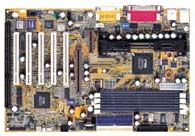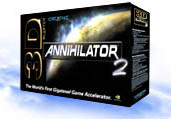Buyer's Guide: High-End Systems - June 2000
by Mike Andrawes on June 13, 2000 3:34 AM EST- Posted in
- Guides
High-end Gaming System
The purpose of
this system is simple – maximum frame rates at all costs. Of course, we already
have a “cost is no object” dream system, so "all costs" isn't taken
quite so literally. We’ve decided to shoot for a price in the $3500 range on
the high-end gaming system. That price is without floppy, keyboard, mouse,
or software. Even though it’s not in the price, we will recommend an OS configuration.
 Processor
– Intel Pentium III 866 - $650
Processor
– Intel Pentium III 866 - $650
We choose the
Pentium III 866 again for our high-end game system as well. Our benchmarks
have shown that the Pentium III 866 outpaces the comparably priced Athlon 900
in Quake 3 and Unreal Tournament. The Athlon 900 takes a slight lead in Expendable,
but needs the clock speed advantage to do so. That 1/3 speed cache of the Athlon
holds it back - Thunderbird with its on-die cache helps quite a bit, but it's
not yet widely available so we had to strike it from consideration.
If you get CB0 core stepping, the 866 can potentially reach 1 GHz with a bit of work. While overclocking is not guaranteed, we’ve had good results with the Coppermine CPU’s.
For more information on all Pentium III's, read our Pentium III 1GHz Review.
 Motherboard
– ASUS P3V4X - $120
Motherboard
– ASUS P3V4X - $120
Since we’ve got
a Pentium III 733, we need a motherboard with official 133 MHz FSB support.
We can strike the i440BX due to its lack of official 133 MHz FSB, although if
you're willing to overclock, it is definitely the best SDRAM chipset currently
available. The i810 is obviously out of the question thanks to its slow integrated
video. Intel’s i820 is out due to the incredibly high cost of RDRAM and its
horrendous performance with SDRAM.
Intel’s i815 on the horizon looks promising – it has support for PC133 SDRAM, official 133 MHz FSB, AGP 4X, Ultra ATA 100, and Intel’s Accelerated Hub Architecture (AHA). The NDA on i815 will finally be lifted in the near future, so we'll know just how well it performs very soon as well. Unfortunately, the big question that remains is whether we'll actually be able to go out and buy an i815 board or if Intel will reserve it mainly for OEM's. Only time will tell.
That leaves us with one clear choice – the VIA Apollo Pro 133A with it’s AGP 4X, Ultra ATA 66, and official 133 MHz FSB support. ASUS and VIA have finally fixed the AGP GART issues with the ASUS P3V4X, allowing that board to garner the AnandTech Editor's Choice Gold Award and earn our recommendation as the motherboard for the High-End gaming system.
Our former selection, the Gigabyte GA-6VX-4X Review is still an excellent choice - the ASUS is just more flexible and better overall in our experience. For more information, read our ASUS P3V4X Review.
Memory – 256MB Corsair
or Mushkin PC133 SDRAM (2x128MB DIMM’s) – $150 x 2
Even though memory
is relatively cheap these days, 256MB is more than enough. We could have dropped
down to 128MB, but the savings didn’t justify the performance. In any case,
as this is our high-end gaming machine, there’s room to move in the budget.
As for the exact brand of memory, we recommend Corsair or Mushkin modules. We use them in our test systems and have had absolutely no problems with them.
 Video
card – Creative Labs 3D Blaster Annihilator 2 - $300
Video
card – Creative Labs 3D Blaster Annihilator 2 - $300
Just last month,
our high-end game system had a $330 GeForce DDR, albeit one with video capture.
Now, for $30 less, the video card gets upgraded to a GeForce 2 GTS. The
majority of GeForce 2 GTS cards on the market are going for $350, but Creative
has undercut the competition. True, it's just a plain jane card, with no TV-in/out,
but it gets the job done and is the most overclockable GeForce 2 GTS we've tested
to date. We were able to push our sample up to 250/395 MHz (core/memory), making
it the first 2 Gigatexel card in the AnandTech lab.
For more information, read our Annihilator 2 Review, GeForce 2 GTS Overclocking Guide, and GeForce 2 GTS Review.
 Monitor
– iiYama VisionMaster PRO 450 - $650
Monitor
– iiYama VisionMaster PRO 450 - $650
Using a Mitsubishi
Diamondtron NF, the iiYama VisionMaster Pro 450 provides a perfectly flat display
surface using the same technology in Sony’s FD Trinitron models, but at a lower
cost. The VisionMaster PRO 450 is a 19” monitor and has been highly acclaimed
here on AnandTech and by owners alike. If you’ve got the funds, we highly recommend
you go with the 22” VisionMaster PRO 510 for about $1000.
For more information, read our iiYama VisionMaster PRO 450 and VisionMaster PRO 510 Reviews.










0 Comments
View All Comments